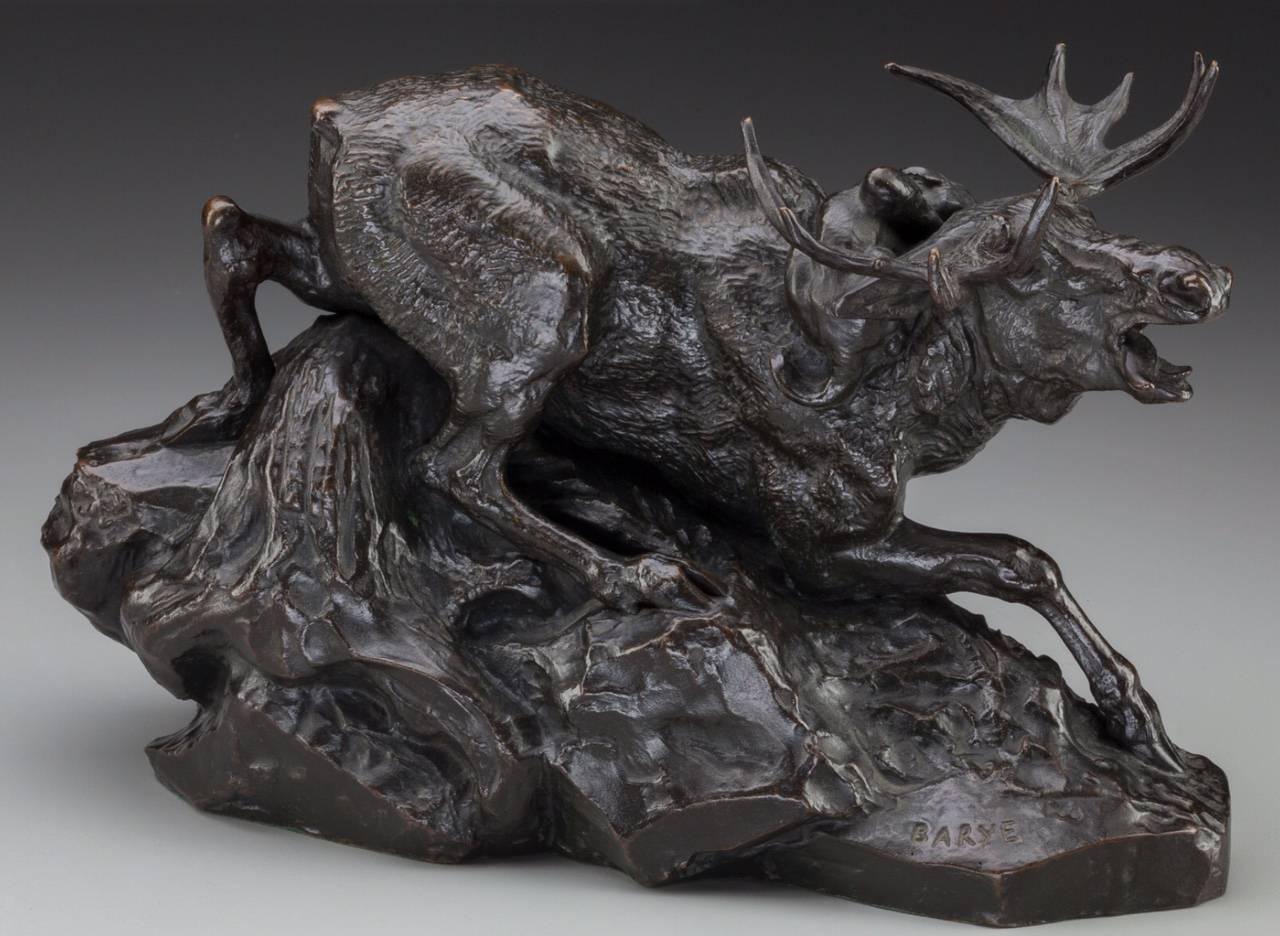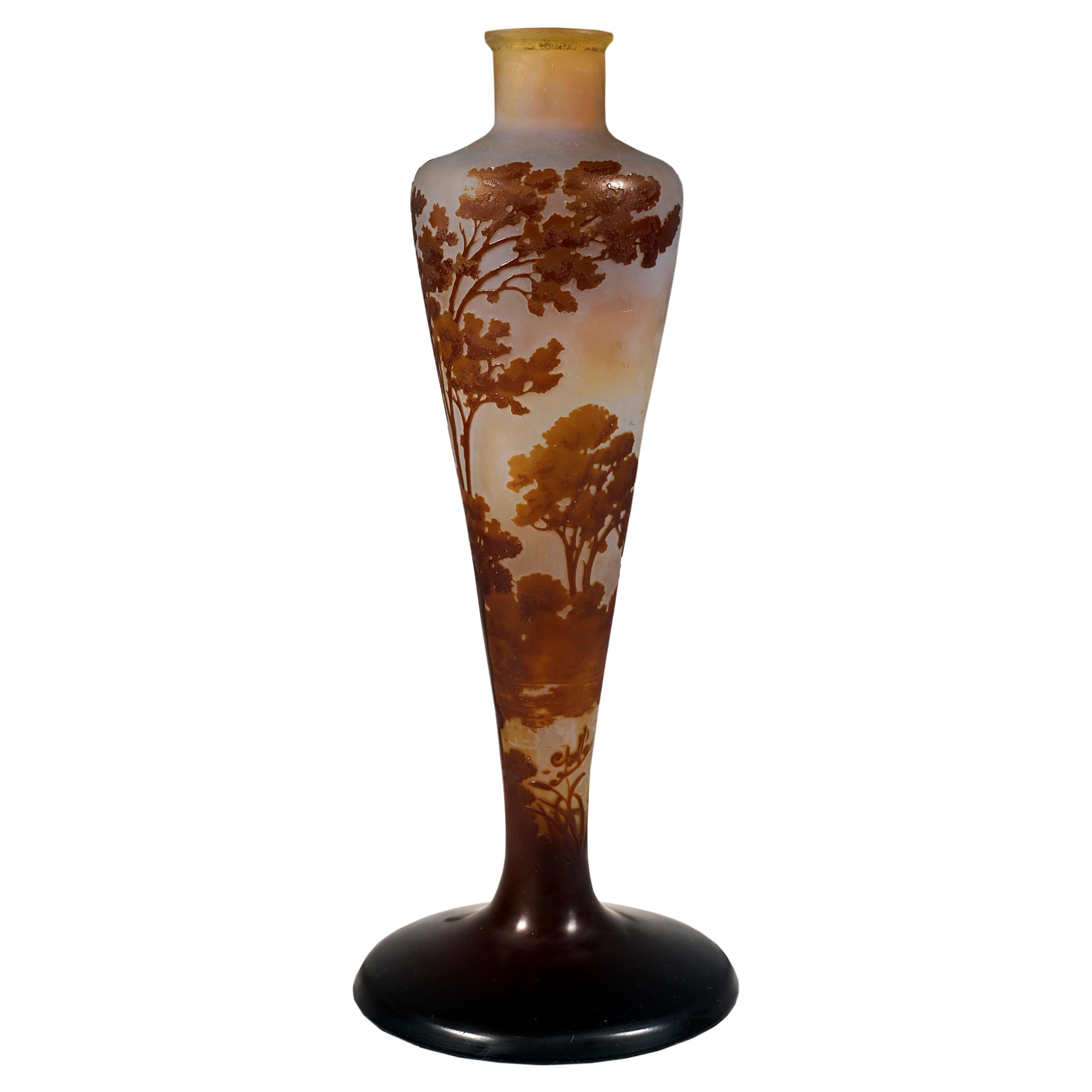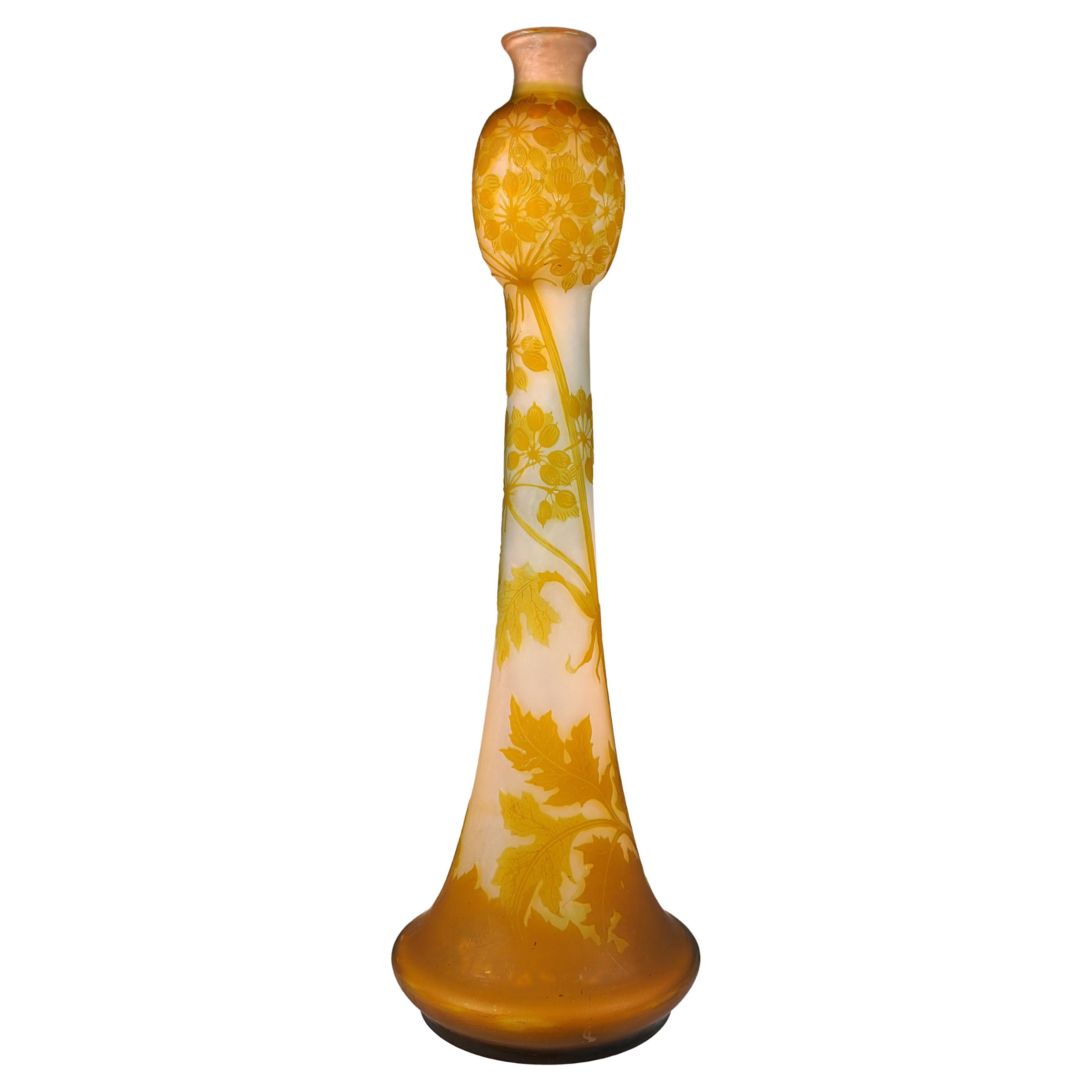Items Similar to Emile Galle Tall Cameo Art Nouveau Vase 1904
Want more images or videos?
Request additional images or videos from the seller
1 of 8
Emile Galle Tall Cameo Art Nouveau Vase 1904
About the Item
A stunning four color wheel carved and acid etched fat vase with pink, yellow, green and white on a cream background. The coloring is strong and the workmanship excellent. A truly explosive expression of flowering and seeding botanicals. Standing at 17.25 Inches; it a beautiful expressive piece. Mix this in with Art Deco design and make a statement!
Signed: Galle with Star (1904-1907)
Height: 17.25 Inches
Diameter: 4.5 Inches
Condition: Excellent with a manufacturer crimp on base.
AVANTIQUES is dedicated to providing an exclusive curated collection of Fine Arts, Paintings, Bronzes, Asian treasures, Art Glass and Antiques. Our inventory represents time-tested investment quality items with everlasting decorative beauty. We look forward to your business and appreciate any reasonable offers. All of our curated items are vetted and guaranteed authentic and as described. Avantiques only deals in original antiques and never reproductions. We stand behind our treasures with a full money back return if the items are not as described.
Gallé was the son of a faience and furniture manufacturer and studied philosophy, botany, and drawing in his youth. He later learned glassmaking at Meisenthal and came to work at his father's factory in Nancy following the Franco-Prussian War. His early work was executed using clear glass decorated with enamel, but he soon turned to an original style featuring heavy, opaque glass carved or etched with plant motifs, often in two or more colours as cameo glass. His friend and patron Robert de Montesquiou sent him to Bayreuth with a recommendation to Cosima Wagner, which led to a great enthusiasm for Parsifal.[1] In 1875, he married Henriette Grimm (1848-1914). In 1877, he then assumed his father’s role as director of the Maison Gallé-Reinemer. In that same year, he was elected Secretary-General for the Société centrale d’horticulture de Nancy.[2] His career took off after his work received praise at the Paris Exhibition of 1878.
Within a decade of another successful showing at the Paris Exhibition of 1889, Gallé had reached international fame and his style, with its emphasis on naturalism and floral motifs, was at the forefront of the emerging Art Nouveau movement.
He continued to incorporate experimental techniques into his work, such as metallic foils and air bubbles, and also revitalized the glass industry by establishing a workshop to mass-produce his, and other artists', designs. The factory would employ 300 workers and artisans at its height, including the notable glassmaker Eugène Rosseau, and remained in operation until 1936
Please also consider Avantiques eclectic Art Glass and Pate De Verre collection including Emile Galle, Daum Nancy, Schneider, Argy Rousseau, Almeric Walter, D’Argental, St Louis, Decorchemont, and Louis Comfort Tiffany Studios. We strive to collect the highest quality Glass pieces in exceptional condition.
- Creator:Emile Gallé (Designer)
- Dimensions:Height: 17.25 in (43.82 cm)Diameter: 4.5 in (11.43 cm)
- Style:Art Nouveau (Of the Period)
- Materials and Techniques:Art Glass,Fired
- Place of Origin:
- Period:1900-1909
- Date of Manufacture:1904
- Condition:Wear consistent with age and use.
- Seller Location:Dallas, TX
- Reference Number:1stDibs: LU1774212248743

About the Seller
4.9
Gold Seller
These expertly vetted sellers are highly rated and consistently exceed customer expectations.
Established in 2000
1stDibs seller since 2015
402 sales on 1stDibs
Typical response time: 1 hour
- ShippingRetrieving quote...Ships From: Dallas, TX
- Return PolicyA return for this item may be initiated within 7 days of delivery.
More From This SellerView All
- Emile Galle Art Nouveau Cameo Floral VaseBy Emile GalléLocated in Dallas, TXEmile Galle wheel carved and acid etched cameo glass vase. This particular case has killer colors and outstanding workmanship. The pink and green combination on the cream background ...Category
Antique Early 1900s French Art Nouveau Vases
MaterialsArt Glass
- Emile Galle Leaves And Pods Art Nouveau Tall VaseBy Emile GalléLocated in Dallas, TXEmile Gallé Cameo Glass Leaves and Pods Vase, circa 1900 Marks: Gallé Height: 15.25 inches (38.7 cm) Width: 6.5 Inches Depth: 5 Inches Condition: Tall vase of colorless glass overlaid in peach, chartreuse and green acid-etched with cascading branches of maple leaves and seed pods. In overall very good condition. Émile Gallé (8 May 1846 in Nancy – 23 September 1904 in Nancy) was a French artist and designer who worked in glass, and is considered to be one of the major innovators in the French Art Nouveau movement. He was noted for his designs of Art Nouveau glass art and Art Nouveau furniture, and was a founder of the École de Nancy or Nancy School, a movement of design in the city of Nancy, France. Gallé born on 4 March 1846 in the city of Nancy, France. His father, Charles Gallé...Category
Antique Early 1900s French Art Nouveau Vases
MaterialsArt Glass
- Large Emile Galle Scenic Cameo VaseBy Emile GalléLocated in Dallas, TXEmile Galle scenic wheel carved and acid etched cameo vase. A beautiful and tall cameo vase by Galle. The 18 - 1/2” tall vase has a background of muted yellow glass near the base, which progresses to blue/gray at mid-vase, and then peach towards the top. Brown, cameo cut trees are generously displayed across the body of the vase, with the addition of a boat in the lake. Signed "Galle". Dimensions: 18 - 1/2” x 10” x 8”. Condition: Very good Émile Gallé (8 May 1846 in Nancy – 23 September 1904 in Nancy) was a French artist and designer who worked in glass, and is considered to be one of the major innovators in the French Art Nouveau movement. He was noted for his designs of Art Nouveau glass art and Art Nouveau furniture, and was a founder of the École de Nancy or Nancy School, a movement of design in the city of Nancy, France. Gallé born on 4 March 1846 in the city of Nancy, France. His father, Charles Gallé, was a merchant of glassware and ceramics who had settled in Nancy in 1844, and his father-in-law owned a factory in Nancy which manufactured mirrors. His father took over the direction of his mother's family business, and began to manufacture glassware with a floral design. He also took over a struggling faience factory and began manufacturing new products. The young Gallé studied philosophy and natural science at the Lycée Imperial in Nancy. At the age of sixteen he went to work for the family business as an assistant to his father, making floral designs and emblems for both faience and glass. In his spare time he became an accomplished botanist, studying with D.A. Godron, the director of the Botanical Gardens of Nancy and author of the leading textbooks on French flora. He collected plants from the region and from as far away as Italy and Switzerland. He also took courses in painting and drawing, and made numerous drawings of plants, flowers, animals and insects, which became subjects of decoration. At the age of sixteen he finished the Lycée in Nancy and went to Weimar in Germany from 1862–1866 to continue his studies in philosophy, botany, sculpture and drawing. In 1866, to prepare himself to inherit the family business, he went to work as an apprentice at the glass factory of Burgun and Schwerer in Meisenthal, and made a serious study of the chemistry of glass production. Some of his early glass and faience works for the family factory at Saint-Clémont were displayed at the 1867 Paris Universal Exposition. In early 1870 he designed a complete set of dishware with a rustic animal designs for the family enterprise. During this time he became acquainted with the painter, sculptor and engraver Victor Prouvé, an artist of the romantic "troubadour" style, who became his future collaborator in the Nancy School. He enlisted for military service in the Franco-Prussian War in 1870, then was demobilised after the disastrous French defeat in 1871 and the French loss to Germany of much of the province of Lorraine, including Meisenthal where he had done his apprenticeship. Thereafter the Cross of Lorraine, the patriotic symbol of the region, became part of his signature on many of his works of art. After his demobilization Gallé went to London, where he represented his father at an exhibition of the arts of France, then to Paris, where he remained for several months, visiting the Louvre and Cluny Museum, studying examples of ancient Egyptian art, Roman glassware and ceramics, and especially early Islamic enamelled...Category
Antique Early 1900s French Art Nouveau Vases
MaterialsArt Glass
- Tall Emile Galle Lily Pedestaled VaseBy Emile GalléLocated in Dallas, TXAn important and exceptional tall cameo vase by Emile Galle. Circa 1900 in the Art Nouveau period. The technique is wheel carved, acid etched and carving to produce this over 20 Inch masterpiece of Tiger Lilies in their various open and closed stages. Galle was foremost a botanist and drew out and designed all his conceptions. What cant be seen in the photos is the cream shadows encompassing all the background flowers and stems. This vase is for serious collectors and those with impeccable taste. Signed: Galle in cameo Measures: Height: 20.2 Inches Diameter: 4.75 Inches Condition: Excellent AVANTIQUES is dedicated to providing an exclusive curated collection of Fine Arts, Paintings, Bronzes, Asian treasures, Art Glass and Antiques. Our inventory represents time-tested investment quality items with everlasting decorative beauty. We look forward to your business and appreciate any reasonable offers. All of our curated items are vetted and guaranteed authentic and as described. Avantiques only deals in original antiques and never reproductions. We stand behind our treasures with a full money back return policy if the items are not as described. Gallé born on 4 March 1846 in the city of Nancy, France. His father, Charles Gallé, was a merchant of glassware and ceramics who had settled in Nancy in 1844, and his father-in-law owned a factory in Nancy which manufactured mirrors. His father took over the direction of his mother's family business, and began to manufacture glassware with a floral design. He also took over a struggling faience factory and began make new products. The young Gallé studied philosophy and natural science at the Lycée Imperial in Nancy. At the age of sixteen he went to work for the family business as an assistant to his father, making floral designs and emblems for both faience and glass. In his spare time he became an accomplished botanist, studying with D.A. Godron, the director of the Botanical Gardens of Nancy and author of the leading textbooks on French flora. He collected plants from the region and from as far away as Italy and Switzerland. He also took courses in painting and drawing, and made numerous drawings of plants, flowers, animals and insects, which became subjects of decoration. At the age of sixteen he finished the Lycée in Nancy and went to Weimar in Germany from 1862-1866 to continue his studies in philosophy, botany, sculpture and drawing. In 1866, to prepare himself to inherit the family business, he went to work as an apprentice at the glass factory of Burgun and Schwerer in Meisenthal, and made a serious study of the chemistry of glass production. Some of his early glass and faience works for the family factory at Saint-Clémont were displayed at the 1867 Paris Universal Exposition. In early 1870 he designed a complete set of dishware with a rustic animal designs for the family enterprise. During this time he became acquainted with the painter, sculptor and engraver Victor Prouvé, an artist of the romantic "troubadour" style, who became his future collaborator in the Nancy School. He enlisted for military service in the Franco-Prussian War in 1870, then was demobilised after the disastrous French defeat in 1871 and the French loss to Germany of much of the province of Lorraine, including Meisenthal where he had done his apprenticeship. Thereafter the Cross of Lorraine, the patriotic symbol of the region, became part of his signature on many of his works of art. After his demobilization Gallé went to London, where he represented his father at an exhibition of the arts of France, then to Paris, where he remained for several months, visiting the Louvre and Cluny Museum, studying examples of ancient Egyptian art, Roman glassware and ceramics, and especially early Islamic enamelled...Category
Antique Early 1900s French Art Nouveau Vases
MaterialsArt Glass
- Emile Galle French Art Nouveau Soufflé Berry VaseBy Emile GalléLocated in Dallas, TXEmile Galle (French 1846 -1904) Soufflé Cameo Vase Large Emile Gallé Mold-Blown Cameo Glass Berries Vase, circa 1910 Yellow and cream background with mold ...Category
Antique Early 1900s French Art Nouveau Vases
MaterialsArt Glass
- Monumental Emile Galle French Cameo Sailboat VaseBy Emile GalléLocated in Dallas, TXEmile Galle (French 1846-1904) A lovely two color cameo vase with a yellow background featuring a lake scene with boats, trees and birds. The detail and fineness of the acid etchi...Category
Antique Early 1900s French Art Nouveau Vases
MaterialsArt Glass
You May Also Like
- Émile Gallé Art Nouveau Cameo Vase, Seascape Decor, France, circa 1904By Emile GalléLocated in Vienna, ATBaluster-shaped vase body on a wide, round base, conical wall that widens upwards, on slightly sloping shoulders a short, narrow neck with a slightly flared mouth edge, colorless gla...Category
Antique Early 1900s French Art Nouveau Glass
MaterialsGlass
- Émile Gallé Art Nouveau Cameo Vase With Daffodil Decor, France, Circa 1904By Emile GalléLocated in Vienna, ATBaluster-shaped vase body on a separate, round base, conically widening walls, on rounded shoulders set short, narrow neck with slightly flared mouth rim, colorless glass with flaky ...Category
Antique Early 1900s French Art Nouveau Glass
MaterialsGlass
- Large Émile Gallé Art Nouveau Cameo Vase, Umbellifers Decor, France, circa 1904By Emile GalléLocated in Vienna, ATVase with a large, round stand, widening like a bulge and then conically narrowing to a narrow opening with a flared rim, colorless glass with pink and light green colored powder inc...Category
Antique Early 1900s French Art Nouveau Glass
MaterialsGlass
- Large Émile Gallé Art Nouveau Cameo Vase, Umbellifers Decor, France, circa 1904By Emile GalléLocated in Vienna, ATLarge baluster-shaped vase with a large, round base, conically narrowing to a tubular vase body with a wide beaded ring just below the narrow opening with...Category
Antique Early 1900s French Art Nouveau Glass
MaterialsGlass
- Emile Gallé, Nancy, Art Nouveau Cameo Vase with Hydrangeas - France ca. 1904By Emile GalléLocated in Bochum, NRWEmile Gallé, Nancy, Art Nouveau Cameo Vase with Hydrangeas - France ca. 1904. Polychrome overlaid decoration with hydrangeas on a milky and pink background, marked Gallé with a star,...Category
Antique Early 1900s French Art Nouveau Vases
MaterialsBlown Glass
- Émile Gallé Art Nouveau Cameo Vase With Silver Mounting, Nancy, France 1904By Emile GalléLocated in Vienna, ATBulbous shoulder vase on a flush stand, short neck piece with silver mount as a ring in a smooth, slightly flared design, on the outside opposite two fully sculptural branch and cone bundles, colourless glass with white powder meltings, overlay in blue-violet and green, meadow flower decoration etched in various stages, matt etched inside and outside. Cameo signature 'Gallé' with star on the wall between the plants. Silver mount hallmarked 'Minerve casquée' for 950 silver, France, and master's mark. Hand-made Cameo Glass: Glass overlaid with several layers, with high-cut worked out motifs. Since the middle of the 19th century, the design has also been done by etching. Cameo glass vessels were already being made in antiquity; at the end of the 19th century, Émile Gallé further developed this glass art, created Art Nouveau designs and employed a large factory in Nancy...Category
Antique Early 1900s French Art Nouveau Glass
MaterialsGlass
Recently Viewed
View AllMore Ways To Browse
Antique Furniture Manufacturer
Antique Furniture Manufacturers
1904 Antique
Tall Art Vase
Tall Antique Vase
Tall Vases Antique
Antique Tall Vases
Antique Tall Vase
Tall Antique Vases
Art Nouveau Movement
Cameo Art
Antique Fire Items
Galle Art Nouveau
Galle Art Glass
Signed Art Nouveau Vases
Signed Art Nouveau Vase
Tall Clear Art
Art Nouveau Furniture Only





